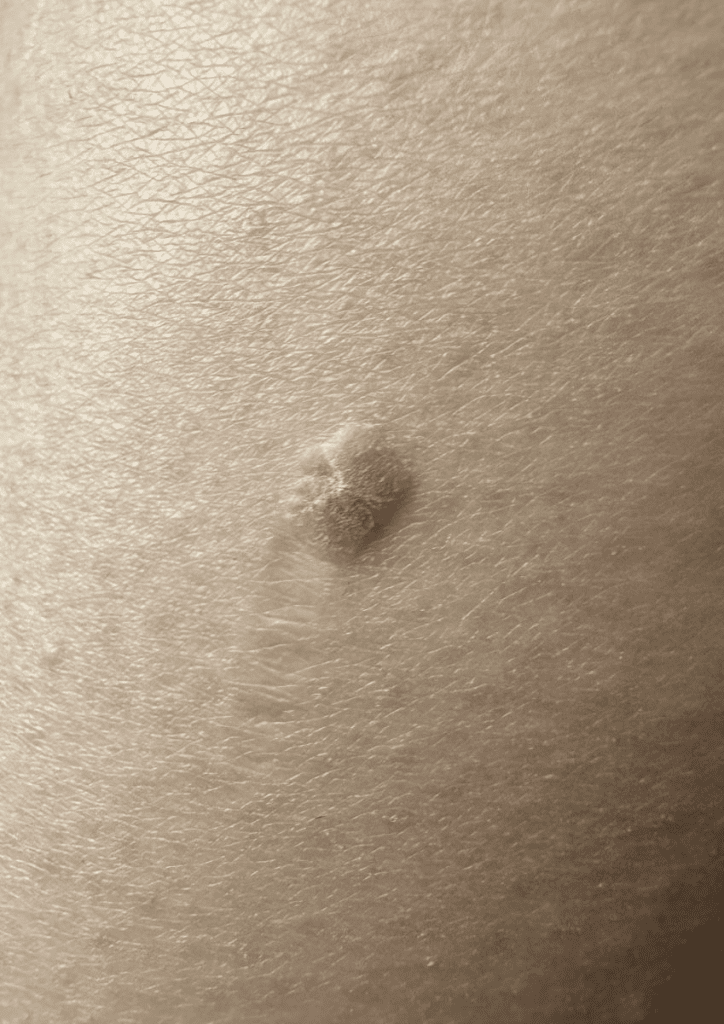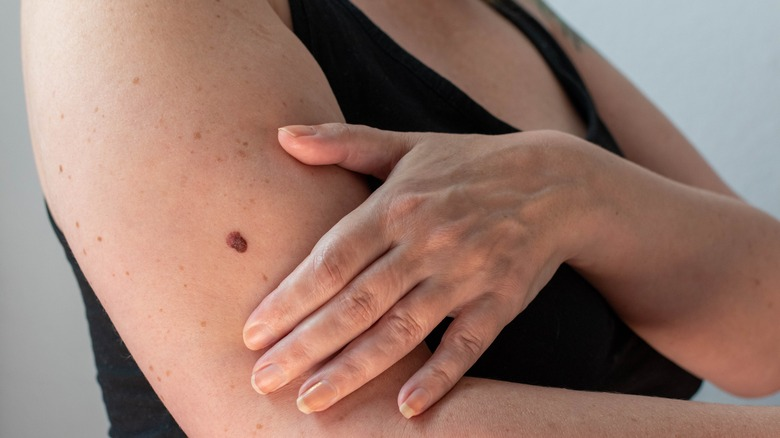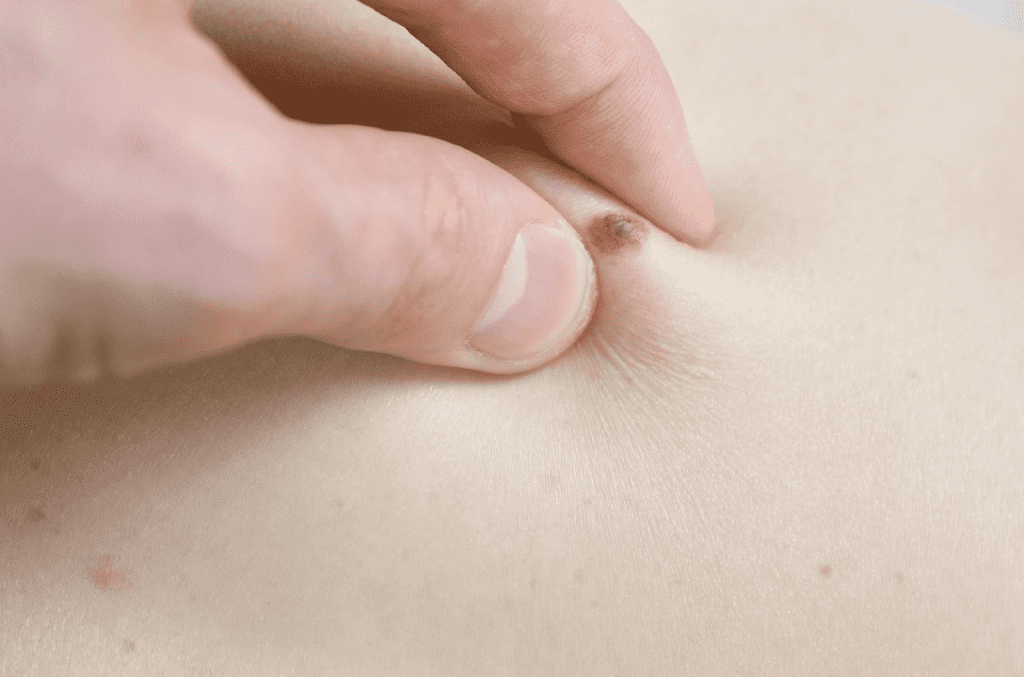Noticing changes in your skin, such as the appearance of a crusty mole, can be concerning, and it’s natural to wonder whether it’s something to worry about. While many moles are benign and harmless, there are certain signs to watch for that could indicate a more serious condition, such as skin cancer. Knowing when to seek medical advice and how to monitor changes in your skin can be crucial for your health and well-being.

In this article, we will explore what could cause a mole to become crusty, the potential warning signs of skin cancer, and what steps you should take if you notice changes in your skin.
Understanding Moles and Skin Changes
Moles are common skin growths formed by clusters of pigment-producing cells known as melanocytes. They can appear anywhere on your skin and most people have between 10 to 40 moles. These growths can develop at birth or appear later in childhood and early adulthood. While moles generally evolve slowly over time, certain changes can signal potential skin issues, including skin cancer.
It’s important to know that moles can change in size, shape, and color over time, but most changes are harmless. However, some changes, especially those that occur suddenly or present in unusual ways—such as becoming crusty—might require medical evaluation to rule out conditions like melanoma.
Signs to Watch For in a Crusty Mole
A mole that becomes crusty, itchy, or starts to bleed is a reason to pay attention. Here are some key signs to monitor:
1. Asymmetry A normal mole is usually symmetrical. If you draw an imaginary line through the middle of a mole, both halves should match. If one half of the mole looks different from the other, it could be a warning sign of melanoma.
2. Border The edges of benign moles are typically smooth and even. If the borders of your mole become irregular, blurred, or jagged, this might indicate an issue. Ragged or poorly defined edges are something you should definitely bring up with a dermatologist.
3. Color A normal mole usually has a consistent color, typically brown or tan. If your mole changes color or contains multiple shades such as black, blue, red, white, or even light spots within the mole, it could be a sign of skin cancer. Any sudden or uneven change in color is worth checking out.
4. Diameter Moles larger than 6mm (about the size of a pencil eraser) should be monitored more closely, especially if they continue to grow in size. However, melanomas can be smaller, so don’t dismiss a small crusty mole just because it’s under 6mm.
5. Evolution Perhaps the most critical sign of all is evolution. If your mole starts to change in any way—whether it’s size, shape, color, or elevation—this could be cause for concern. Other changes, like a mole becoming crusty, itchy, or starting to bleed, should prompt an immediate visit to a healthcare provider.
Why Do Moles Become Crusty?

A crusty mole can develop for several reasons, and not all of them are cancerous. However, any sudden change in a mole, including crusting, should be taken seriously. Here are a few reasons why a mole might become crusty:
- Irritation: Sometimes moles can become irritated from clothing, friction, or other external factors, leading to crusting or scabbing.
- Infection: An infected mole can appear crusty or inflamed. If the mole becomes painful or starts oozing, this could indicate infection.
- Skin Cancer: One of the more serious reasons a mole might become crusty is due to melanoma, a type of skin cancer. Melanoma can cause a mole to crust, bleed, or change in other concerning ways. Early detection is key to treating melanoma effectively.
When to Seek Medical Advice
If you notice that your mole has become crusty or is showing any of the warning signs mentioned above, it’s important to consult a dermatologist. A healthcare provider can perform a thorough examination and, if necessary, conduct a biopsy to determine if the mole is benign or malignant.
Annual skin checks by a professional are highly recommended, especially if you have a history of prolonged sun exposure, sunburns, or a family history of skin cancer. Regular monitoring ensures that any concerning changes are caught early, which is critical for effective treatment.
The Importance of Early Detection
When it comes to skin cancer, early detection is crucial. If caught early, most types of skin cancer, including melanoma, are treatable. The longer a cancerous mole goes unnoticed, the more likely it is to spread and become more difficult to treat.
Performing regular self-exams can help you spot new moles or changes to existing ones. Use a mirror or ask someone to help you check areas that are hard to see, like your back or the backs of your legs. Keep a journal or take pictures to track changes over time.
How to Monitor Moles for Changes

Here’s a simple guide to monitoring your moles:
- Perform a monthly self-check to look for new moles or changes in existing ones.
- Use the ABCDE method (Asymmetry, Border, Color, Diameter, Evolution) to evaluate any suspicious moles.
- Keep track of any moles that itch, bleed, or become crusty.
- Schedule regular dermatology checkups, especially if you have risk factors like a family history of skin cancer or frequent sun exposure.
Preventing Skin Cancer
Protecting your skin from harmful UV rays is one of the best ways to prevent skin cancer. Here are some effective prevention tips:
- Use Sunscreen: Always wear broad-spectrum sunscreen with at least SPF 30, even on cloudy days.
- Wear Protective Clothing: Hats, long sleeves, and sunglasses can help shield your skin from the sun’s harmful rays.
- Avoid Tanning Beds: Tanning beds emit harmful UV radiation that can increase your risk of developing skin cancer.
- Seek Shade: When outdoors, try to stay in the shade, especially during peak sun hours (10 a.m. to 4 p.m.).
Conclusion
While a crusty mole on your thigh might be harmless, it’s essential to be vigilant about any changes to your skin. Moles that change in appearance, color, or texture—or that become crusty, itchy, or bleed—should be evaluated by a healthcare provider. Early detection of skin changes can make a significant difference in preventing or treating skin cancer. Remember, regular self-exams and dermatology checkups are key to maintaining healthy skin. If in doubt, always seek medical advice.